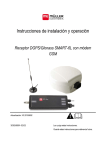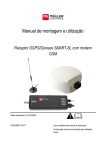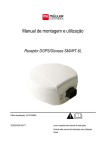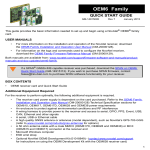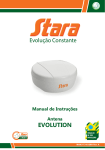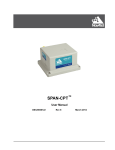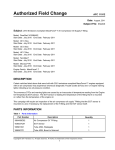Download Installation and Operating Instructions
Transcript
Installation and Operating Instructions DGPS/Glonass receiver SMART-6L with RTK radio modem Version: V3.20150602 30302489-02-EN Read and follow these operating instructions. Keep these operating instructions in a safe place for later reference. Company details Document Installation and Operating Instructions Product: DGPS/Glonass receiver SMART-6L with RTK radio modem Document number: 30302489-02-EN Original language: German Copyright © Müller-Elektronik GmbH & Co.KG Franz-Kleine-Straße 18 33154 Salzkotten Germany Phone: ++49 (0) 5258 / 9834 - 0 Fax: ++49 (0) 5258 / 9834 - 90 Email: [email protected] Homepage: http://www.mueller-elektronik.de Table of contents Table of contents 1 For your safety 4 1.1 Basic safety instructions 4 1.2 Intended use 4 1.3 Layout and meaning of warnings 5 1.4 Disposal 5 2 Product description 6 2.1 About the GPS receiver 6 2.2 Meaning of the LED lights 7 3 Brief instructions 9 4 Assembly instructions 10 4.1 Mounting the GPS receiver 10 4.2 Mounting the antenna 11 4.3 Preparing a junction box for connecting a terminal 11 4.4 Securing the junction box in the vehicle 13 4.5 Connecting the components 14 4.6 Activating the driver of the GPS receiver on a terminal 15 4.7 Configuring the GPS receiver 15 5 Technical specifications 17 6 List of accessories 18 V3.20150602 3 1 1 1.1 For your safety Basic safety instructions For your safety Basic safety instructions Please read the following safety instructions carefully before using the product for the first time. ▪ Do not make any unauthorized modifications to the product. Unauthorized modifications or use may impair safety and reduce the service life or operability of the unit. Modifications are considered unauthorized if they are not described in the product documentation. ▪ Comply with road traffic rules. Stop the vehicle before operating the GPS receiver or connected components. Systems with modem If you use the GPS receiver with a modem, note that the modem emits radio waves when switched on. These can interfere with other devices or be harmful to human health. You should therefore follow the following instructions when using the GPS receiver with a modem: ▪ If you wear a medical device, ask your doctor or the device manufacturer about how to prevent hazards. Medical devices such as pacemakers or hearing aids can be affected by the radio transmissions of modems. ▪ If you wear a pacemaker, keep the modem away from the pacemaker. ▪ Switch off the modem as soon as you are close to petrol stations, chemical plants, biogas plants or other locations where combustible gases or fumes can occur. These gases can be ignited by a spark and explode. ▪ Maintain a minimum distance of 20 cm (8 inches) between the antenna of the modem and your body. ▪ Never switch on the modem in an aircraft. Ensure that it is not accidentally switched on during flight. 1.2 Intended use The product is intended for accurate positioning of agricultural vehicles. The product is intended exclusively for use in agriculture. The manufacturer shall not be held responsible for any other use of the system. The operating instructions form part of the product. The product may only be used in accordance with these operating instructions. The manufacturer cannot be held liable for any personal injury or property damage resulting from such non-compliance. All risk arising from improper use lies with the user. 4 30302489-02-EN For your safety Layout and meaning of warnings 1.3 1 Layout and meaning of warnings All safety instructions found in these Operating Instructions are composed in accordance with the following pattern: WARNING This signal word identifies medium-risk hazards, which could potentially cause death or serious physical injury, if not avoided. CAUTION This signal word identifies low-risk hazards, which could potentially cause minor or moderate physical injury or damage to property, if not avoided. NOTICE This signal word identifies actions which could lead to operational malfunctions if performed incorrectly. These actions require that you operate in a precise and cautious manner in order to produce optimum work results. There are some actions that need to be performed in several steps. If there is a risk involved in carrying out any of these steps, a safety warning will appear in the instructions themselves. Safety instructions always directly precede the step involving risk and can be identified by their bold font type and a signal word. Example 1. NOTICE! This is a notice. It warns that there is a risk involved in the next step. 2. Step involving risk. 1.4 Disposal When it has reached the end of its service life, please dispose of this product as electronic scrap in accordance with all applicable waste management laws. V3.20150602 5 2 2 2.1 Product description About the GPS receiver Product description About the GPS receiver The GPS receiver can be used worldwide. In Europe and North America, it works with the GPS system and the WAAS and EGNOS correction systems. In locations where WAAS and EGNOS cannot be used, the GPS receiver can use the GPS system together with Glonass satellites. The correction signal is then calculated internally (using GL1DE technology). The GPS receiver can also function with other correction signals. In order to do this, the GPS receiver must be connected with a GPS modem or an RTK radio modem. Adhesive plate for antenna Connector for antenna cable Modem installed in junction box Connector for the power supply cable DGPS/Glonass receiver SMART6L Antenna Metal plate for antenna Magnetic plate Connector cable for the steering job computer Connector cable - DGPS/Glonass receiver to modem Power supply cable Glonass Glonass is a Russian satellite system which can be used in addition to the American GPS system. 6 30302489-02-EN Product description Meaning of the LED lights 2 WAAS and EGNOS WAAS and EGNOS are satellite-based correction services which can be used in Europe and North America. GL1DE GL1DE technology can be used in parallel to other methods. This thus further increases path-to-path accuracy. RTK Systems which work with RTK consist of a fixed base station and a mobile receiver. The base station transmits correction signals to the mobile receiver by means of a modem. This enables levels of accuracy in the centimeter range. Accuracies The accuracy of the GPS receiver is dependent on the site in which you are located. Accuracy is also described using the following values: ▪ Path-to-path accuracy describes the maximum displacement of the GPS position during field work. A path-to-path accuracy of 2.5 cm means that the overlap or defect during parallel movements is a maximum of 2.5 cm. ▪ Absolute accuracy is the accuracy with which a movement can be repeated after days, months or years. An absolute accuracy of 2.5 cm means that the deviation of a movement after one year is a maximum of 2.5 cm. This maximum deviation also applies if, after one year has passed, you use the field limits, guidance lines, obstacles, etc. in the TRACK-Leader application from the previous year. 2.2 Meaning of the LED lights The GPS receiver has three LED lights, which display the current state of the GPS receiver. Green LED light Yellow LED light Red LED light ▪ Green: The GPS receiver is receiving GPS signals. ▪ Yellow: The GPS receiver is not receiving GPS signals. There is a fault. V3.20150602 7 2 Product description Meaning of the LED lights ▪ Red: The GPS receiver is operating. The unit is live. 8 30302489-02-EN Brief instructions 3 3 Brief instructions This chapter will provide you with an overview of the steps which you will need to complete in order to use the product. 1. Mount the GPS receiver. [➙ 10] 2. Mount the antenna. [➙ 11] 3. If you want to connect a terminal, you will need to prepare a junction box for connecting a terminal. [➙ 11] 4. Secure the junction box with the modem in the vehicle. [➙ 13] 5. Connect the components. [➙ 14] 6. Activate the GPS receiver on a terminal. [➙ 15] 7. Configure the GPS receiver [➙ 15]. V3.20150602 9 4 Assembly instructions Mounting the GPS receiver 4 4.1 Assembly instructions Mounting the GPS receiver GPS receiver on the roof of a tractor NOTICE The GPS receiver needs an open view of the sky. ◦ Mount the GPS receiver on the roof of the vehicle cabin. ◦ Avoid obscuring the GPS receiver's view of the sky. Procedure You fit the GPS receiver as follows: 1. Identify a suitable location on the roof of the vehicle: as far forward as possible, and in the center of the vehicle. 2. Use alcohol to clean the position on which will you want to mount the GPS receiver. 3. Expose the adhesive surface of the magnetic plate. The notch in the magnetic plate must face away from the direction of travel. 4. Place the GPS receiver onto the magnetic plate so that it locks. The connection must thus face away from the direction of travel. ⇨ You have now mounted the GPS receiver onto the roof of the vehicle. ⇨ You can now connect the GPS receiver to a terminal. 10 30302489-02-EN Assembly instructions Mounting the antenna 4.2 4 Mounting the antenna CAUTION Crushing hazard from a very strong magnet The base of the antenna is a very strong magnet. ◦ Never insert your fingers between the base of the antenna and a metal surface. ◦ Grip the antenna firmly in your hands, but do not place your fingers on the magnetic base. NOTICE The antenna requires an unobstructed view of the sky. ◦ Mount the antenna on the roof of the vehicle cab. ◦ Avoid placing the antenna in the shade. Procedure To mount the antenna: You have fitted the GPS receiver. 1. Identify a suitable location on the roof of the vehicle: this should be as far away as possible from the mounted GPS receiver. 2. Use alcohol to clean the position on which will you will mount the antenna. 3. Glue the double sided adhesive plate to the cleaned surface. 4. Clean the provided metal plate. 5. Remove the paper from the adhesive plate and glue this onto the metal plate. 6. Position the antenna on the metal plate. 4.3 ⇨ You have fitted the antenna. Preparing a junction box for connecting a terminal If you are using the junction box on a terminal and without automatic steering, you need an additional power supply. WARNING Physical injury due to electrical shock If voltage is present during assembly, this can lead to physical injury due to electrical shock. ◦ Disconnect the power supply from the vehicle battery before working on the junction box. V3.20150602 11 4 Assembly instructions Preparing a junction box for connecting a terminal CAUTION Damage to the vehicle's electrical system Switching the polarity of the cables can cause damage to the vehicle's electrical system. ◦ Pay attention to the polarity of the cable cores and the terminals. Procedure Proceed as follows if you want to connect the power supply cable: The junction box is not connected to the power supply. 1. Screw the junction box open. 2. Slide the lid of the junction box carefully to the back. 3. Replace the blanking plug from the power supply connector with a grommet. 4. Guide the power supply cable through the opening. 12 30302489-02-EN Assembly instructions Securing the junction box in the vehicle 4 5. Remove the brown cable core from the left clipper block. Use a screwdriver to do this. 6. Insulate the removed brown cable core because it is live. 7. Insert the cable core of the power supply cable into the clipper block. Pay attention to the proper colours. You can also see the proper colour by the abbreviation beside the clipper block. The table at the end of this section shows the abbreviations for the colours. 8. Close the screw connections of the connectors. 9. Slide the lid of the junction box back on. 10. Screw the junction box closed. ⇨ You have prepared the junction box for connection to a terminal. 4.4 Abbreviation Color gn green ge yellow ws white br brown bl blue Securing the junction box in the vehicle To secure the junction box in the vehicle: You have prepared a junction box for connecting a terminal if you want to connect a terminal. V3.20150602 13 4 Assembly instructions Connecting the components 1. Find a dry spot in the vehicle cab. Make sure that the distances between the junction box, the GPS receiver and the antenna are not too large so that the cables are sufficiently long. 2. Secure the junction box tightly. 4.5 ⇨ You can now connect to the individual components. Connecting the components CAUTION Kink damage to the antenna cable The antenna cable can become damaged if it is bent during installation. ◦ Do not bend the antenna cable. CAUTION Damage to the vehicle's electrical system Switching the polarity of the cables can cause damage to the vehicle's electrical system. ◦ Pay attention to the polarity of the cable cores and the terminals. Procedure To connect the components: You have fitted the GPS receiver. You have fitted the antenna. You have fitted the junction box. 1. Run the cable for the GPS receiver from the junction box out of the vehicle cab. 2. Connect the cable to the GPS receiver. 3. Run the antenna cable into the vehicle cab. 4. Connect to the antenna cable to the junction box. 5. Connect the junction box with the steering job computer or the terminal by means of the connector cable. 6. If you are not going to use a steering job computer, connect the power supply cable to the appropriate power supply socket on the vehicle. Ensure that voltage is only generated when you are working with the GPS receiver. This will keep your data volume low. ⇨ You have connected to the components to each other. 14 30302489-02-EN Assembly instructions Activating the driver of the GPS receiver on a terminal 4.6 4 Activating the driver of the GPS receiver on a terminal You will need to activate the GPS receiver differently depending on where you have connected it. Version Driver Via the terminal's serial interface "AG-STAR, SMART-6L" or "GPS_STD" Via the TRACK-Leader TOP steering job "PSR CAN" computer Via the TRACK-Leader AUTO steering job computer "TRACK-Leader AUTO" You can read how to activate a driver in the operating instructions for the terminal. 4.7 Configuring the GPS receiver The GPS receiver can be configured differently for various terminals. You can find out how to do this in the operating instructions for the terminal. The following tables show the values which you can select in the parameter "correction signal" during configuration: Value Path-to-path accuracy Absolute accuracy EGNOS/WAAS 15cm 60cm EGNOS/WAAS <15 cm + GL1DE 60cm GL1DE 15-18cm 70cm RTK radio 2cm 2.5cm RTK-GSM 2cm 2.5cm TerraStar 5cm 5-10cm Comment Alternative to EGNOS/WAAS for India, Africa and South America Information for GL1DE If you have selected a correction signal with GL1DE, please note: ▪ Switch the GPS receiver off when driving on roads. V3.20150602 15 4 Assembly instructions Configuring the GPS receiver ▪ After starting the systems each time, it takes ca. 5 minutes until the system is ready for operation. Wait on the field to be worked during this time, before you start working. ▪ Ensure that the GPS receiver does not lose the GPS signal during work. If the signal gets lost, it can cause the GL1DE to restart. This can lead to track offset. Information for TerraStar If you have selected "TerraStar" as a correction signal, please note: ▪ The accuracies are available ca. 10 to 15 minutes after switching on the GPS receiver under the open sky. ▪ If the GPS signal fails due to shadowing by buildings or trees, the full accuracy is only available again after ca. 5 minutes. For this reason, you should avoid driving along rows of trees or buildings. 16 30302489-02-EN Technical specifications 5 5 Technical specifications GPS receiver SMART-6L Operating voltage 8 – 36 V DC Current consumption 241 mA at 12V DC Power input 2.9 W GPS standard NMEA 0183 Frequencies GPGGA, GPVTG, GPGSA, GPZDA, GPRMC Transmission rate 19200-115200 baud Data bits 8 Parity no Stop bits 1 Flow control None Radio modem V3.20150602 VHF UHF Operating temperature -40 - +75 °C -40 - +75 °C Storage temperature -40 - +85 °C -40 - +85 °C Transmission rate 1200-38400 Baud 300-38400 Baud Data bits 8 8 Parity no no Stop bits 1 1 Operating voltage 8 – 30V DC 9 – 30V DC Current consumption 550 mA at 1 2V DC 585 mA at 1 2V DC Band 135-174 MHz 403-473 MHz 17 6 List of accessories 6 List of accessories GPS receiver Item number Item name 3030247606 DGPS/Glonass receiver SMART-6L with connector cable to the terminal 3130247606 DGPS/Glonass receiver SMART-6L with no connector cable to the terminal Complete GPS receiver package with additional components Item number Item name 3030248901 DGPS/Glonass receiver SMART-6L with GSM modem, GSM antenna and RTK activation 30302489 DGPS/Glonass receiver SMART-6L with VHF radio modem (135-174 MHz), VHF mobile antenna and RTK activation 3030248900 DGPS/Glonass receiver SMART-6L with UHF radio modem (403-473 MHz), UHF mobile antenna and RTK activation Retrofit Item number Item name 3030248920 GSM modem 3030248912 GSM antenna for GSM modem 3030248921 VHF radio modem (135-174 MHz) 3030248922 UHF radio modem (403-473 MHz) 3030248910 Mobile antenna for VHF radio modem 3030248911 Mobile antenna for UHF radio modem 3030248931 RTK activation Connection cable Item number Item name 31302476 Connector cable - DGPS/Glonass receiver to terminal 31302453 Adapter cable for connection to the TRACK-Leader TOP steering job computer 18 30302489-02-EN List of accessories 6 Mounting accessories Item number Item name 3130247601 DGPS/Glonass receiver – Magnetic plate and adhesive tape Additional items Item number Item name 3030248150 RTK base station, VHF max. 5 W 3030248151 RTK base station, UHF max. 35 W V3.20150602 19



















